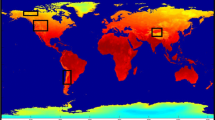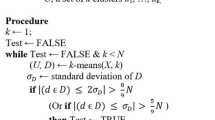Abstract
Spatial outliers represent locations which are significantly different from their neighborhoods even though they may not be significantly different from the entire population. Identification of spatial outliers can lead to the discovery of unexpected, interesting, and implicit knowledge, such as local instability. In this paper, we first provide a general definition of S-outliers for spatial outliers. This definition subsumes the traditional definitions of spatial outliers. Second, we characterize the computation structure of spatial outlier detection methods and present scalable algorithms. Third, we provide a cost model of the proposed algorithms. Finally, we experimentally evaluate our algorithms using a Minneapolis-St. Paul (Twin Cities) traffic data set.
Similar content being viewed by others
References
M. Ankerst, M.M. Breunig, H.P. Kriegel, and J. Sander. “Optics: Ordering points to identify the clustering structure,” in Proceedings of the 1999 ACM SIGMOD International Conference on Management of Data, Philadephia, Pennsylvania, U.S.A., 49–60, 1999.
V. Barnett and T. Lewis. Outliers in Statistical Data. 3rd edition, John Wiley: New York, 1994.
M.M. Breunig, H.P. Kriegel, R.T. Ng, and J. Sander. “Optics-of: Identifying local outliers,” in Proc. of PKDD '99, Prague, Czech Republic, Lecture Notes in Computer Science (LNAI 1704), pp. 262–270, Springer Verlag, 1999.
D. Cook, J. Symanzik, and J.J. Majure. “The variogram cloud link,” in http://www.public.iastate.edu/dicook/compgeo/VariogramCloudExample.html, 1996.
J. Gray, A. Bosworth, A. Layman, and H. Pirahesh. “Data cube: A relational aggregation operator generalizing group-by, cross-tab, and sub-total,” in Proceedings of the Twelfth IEEE International Conference on Data Engineering, 152–159, 1995.
O. Gunther. “The design of the cell tree: An object-oriented index structure for geometric databases,” in Proc. 5th Intl. Conference on Data Engineering, February 1989.
R.P. Haining. Spatial Data Analysis in the Social and Environmental Sciences. Cambridge University Press, 1993.
D. Hawkins. Identification of Outliers. Chapman and Hall, 1980.
R. Johnson. Applied Multivariate Statistical Analysis. Prentice Hall, 1992.
G. Karypis and V. Kumar. Metis Home Page. http://www-users.cs.umn.edu/~karypis/metis/metis/main.html.
G. Karypis and V. Kumar. “Multilevel k-way partitioning scheme for irregular graphs,” Journal of Parallel and Distributed Computing, Vol. 48(1):96–129, 1998.
E. Knorr and R. Ng. “A unified notion of outliers: Properties and computation,” in Proc. of the International Conference on Knowledge Discovery and Data Mining, 219–222, 1997.
E. Knorr and R. Ng. “Algorithms for mining distance-based outliers in large datasets,” in Proc. 24th VLDB Conference, 1998.
E.M. Knorr, R.T. Ng, and V. Tucakov. “Distance-based outliers: Algorithms and applications,” VLDB Journal, Vol. 8(3–4):237–253, 2000.
Anselin Luc. “Exploratory spatial data analysis and geographic information systems,” in M. Painho (Ed.), New Tools for Spatial Analysis, 45–54, 1994.
Anselin Luc. “Local indicators of spatial association: LISA,” Geographical Analysis, Vol. 27(2):93–115, 1995.
Minnesota Department of Transportation Traffic Management Center. http://www.dot.state.mn.us/tmc/.
A. Orenstein and T. Merrett. “A class of data structures for associative searching,” in Proc. Symp. on Principles of Database Systens, 181–190, 1984.
F. Preparata and M. Shamos. Computational Geometry: An Introduction. Springer Verlag, 1988.
S. Ramaswamy, R. Rastogi, and K. Shim. “Efficient algorithms for mining outliers from large data sets,” in Proceedings of the 2000 ACM SIGMOD International Conference on Management of Data, Vol. 29:427–438, ACM, 2000.
I. Ruts and P. Rousseeuw. “Computing depth contours of bivariate point clouds,” in Computational Statistics and Data Analysis, Vol. 23:153–168, 1996.
S. Shekhar and S. Chawla. A Tour of Spatial Databases. Prentice Hall, 2003, ISBN: 0–13–017480–7.
S. Shekhar, S. Chawla, S. Ravada, A. Fetterer, X. Liu, and C.T. Lu. “Spatial databases: Accomplishments and research needs,” IEEE Transactions on Knowledge and Data Engineering, Vol. 11(1):45–55, 1999.
S. Shekhar and D.-R. Liu. “CCAM: A connectivity-clustered access method for aggregate queries on transportation networks,” IEEE Transactions on Knowledge and Data Engineering, Vol. 9(1):102–119, January 1997.
S. Shekhar, C.T. Lu, X. Tan, S. Chawla, and R.R. Vatsavai. “Map cubes: A visualization tool for spatial data warehouses,” in Harvey Miller and Jiawei Han (Eds.), Georgraphic Data Mining and Knowledge Discovery, Taylor and Francis, 2001.
S. Shekhar, C.T. Lu, and P. Zhang. “A unified approach to spatial outliers detection,” in Department of Computer Science and Engineering, University of Minnesota, Technical Report TR 01–045, http://www.cs.vmn.edu/tech_reports/?year=2001, 2001.
M.F. Worboys. GIS—A Computing Perspective. Taylor and Francis, 1995.
D. Yu, G. Sheikholeslami, and A. Zhang. “Find-out: Finding outliers in very large datasets,” in Department of Computer Science and Engineering State University of New York at Buffalo Buffalo, Technical report 99–03, http://www.cse.buffalo.edu/tech-reports/, 1999.
Author information
Authors and Affiliations
Rights and permissions
About this article
Cite this article
Shekhar, S., Lu, CT. & Zhang, P. A Unified Approach to Detecting Spatial Outliers. GeoInformatica 7, 139–166 (2003). https://doi.org/10.1023/A:1023455925009
Issue Date:
DOI: https://doi.org/10.1023/A:1023455925009




